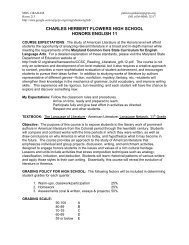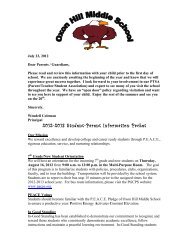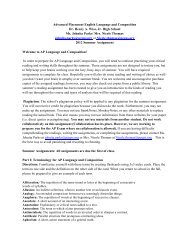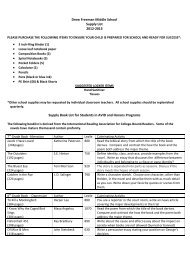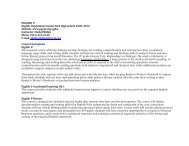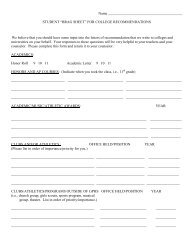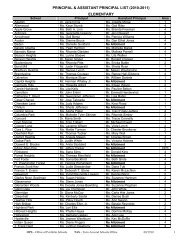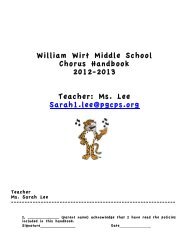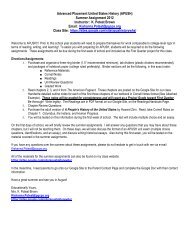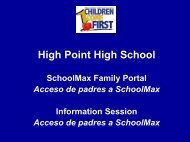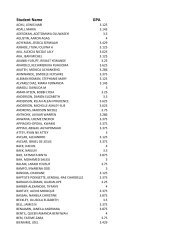Grading - Prince George's County Public School System
Grading - Prince George's County Public School System
Grading - Prince George's County Public School System
You also want an ePaper? Increase the reach of your titles
YUMPU automatically turns print PDFs into web optimized ePapers that Google loves.
<strong>Prince</strong> George’s <strong>County</strong> <strong>Public</strong> <strong>School</strong>s • www.pgcps.org<br />
Administrative Procedure 5121.2<br />
<strong>Grading</strong> and Reporting<br />
for<br />
Middle <strong>School</strong>s<br />
Grade Six<br />
through<br />
Grade Eight<br />
BOARD OF EDUCATION<br />
Verjeana M. Jacobs, Esq., Chair • Peggy Higgins, Vice Chair • Henry P. Armwood, Jr. • Donna Hathaway Beck • Carolyn M. Boston •<br />
Edward Burroughs, III • Patricia Eubanks • Rosalind A. Johnson • Amber P. Waller • Faith Jackson, Student Member<br />
William R. Hite, Ed.D., Superintendent of <strong>School</strong>s and Secretary / Treasurer
TABLE OF CONTENTS<br />
Preface to Administrative Procedure 5121.2.................................................................................................1<br />
Rationale ...............................................................................................................................................2<br />
<strong>Grading</strong> Elements...........................................................................................................................................2<br />
Reporting and Recording Grades...................................................................................................................2<br />
<strong>Grading</strong> – Lawful Absences (Refer to A.P. 5113)..........................................................................................3<br />
<strong>Grading</strong> – Unlawful Absences (Refer to A.P. 5113)......................................................................................4<br />
Determining Final Grades..............................................................................................................................5<br />
Grade Point Average (GPA)...........................................................................................................................5<br />
Honor Roll ....................................................................................................................................................6<br />
Progress Reports............................................................................................................................................6<br />
Report Cards..................................................................................................................................................6<br />
Parent Conferences........................................................................................................................................6<br />
Outstanding Obligations for Textbooks and Other Educational Materials....................................................7<br />
Students Receiving Special Education Services............................................................................................7<br />
Students Receiving English for Speakers of Other Languages (ESOL) Services.........................................7<br />
Transfer Students...........................................................................................................................................8<br />
Dropped Courses............................................................................................................................................8<br />
Repeated Courses...........................................................................................................................................9<br />
Procedures for Appeal....................................................................................................................................9<br />
Authorization of Grade Change...................................................................................................................10<br />
Printing and Requests for Reprints..............................................................................................................10<br />
Related Procedures and Information............................................................................................................10<br />
Maintenance and Update Of These Procedures...........................................................................................10<br />
Cancellations and Supersedures................................................................................................................... 11<br />
Effective Date.............................................................................................................................................. 11<br />
<strong>Grading</strong> Factors by Subject.....................................................................................................................12-29<br />
II<br />
<strong>Prince</strong> George’s <strong>County</strong> <strong>Public</strong> <strong>School</strong>s Administrative Procedure 5121.2
PREFACE TO ADMINISTRATIVE<br />
PROCEDURE 5121.2<br />
The purpose of Administrative Procedure 5121.2 is to provide guidance to administrators and teachers in the<br />
implementation of the grading and reporting systems to be used in all middle schools and centers and for all sixth<br />
grade students in elementary schools in <strong>Prince</strong> George’s <strong>County</strong> <strong>Public</strong> <strong>School</strong>s (PGCPS).<br />
COMAR (Code of Maryland Regulations) 13A.03.02.12D states that each local school system shall develop a<br />
written policy on grading and reporting. The policy must include, but not be limited to, the following:<br />
A. The establishment of instructional objectives and standards of performance for each subject.<br />
B. Factors to be used in determining grades.<br />
C. Reporting contacts between parent (guardian) and teacher.<br />
D. Compliance with the student record requirements as set forth in COMAR 13A.08.02.<br />
Each local school system will file its grading and reporting policies with the State Superintendent of <strong>School</strong>s.<br />
The Board of Education believes that all students can learn and achieve at high levels, that rigorous performance<br />
standards and achievement standards are essential components of developing and delivering quality instruction,<br />
and that regular assessment is an important component of an effective teaching and learning environment and an<br />
important tool in measuring students’ learning (Board Policy 5121).<br />
Administrative Procedure 5121.2<br />
1<br />
<strong>Prince</strong> George’s <strong>County</strong> <strong>Public</strong> <strong>School</strong>s
Rationale<br />
1. <strong>Grading</strong> and promotion within the <strong>Prince</strong> George’s <strong>County</strong> <strong>Public</strong> <strong>School</strong> <strong>System</strong> will be based upon the<br />
degree of success an individual student has achieved in completing the educational program designed to meet<br />
his/her unique needs.<br />
2. Every student will have the opportunity to earn grades that reflect his/her ability to demonstrate learning<br />
outcomes and be graded only in accordance with their achievement on material or information based on<br />
specified learning outcomes and approved curricula.<br />
3. The bell curve will not be used as a basis for determining student grades.<br />
<strong>Grading</strong> Elements<br />
1. The grades eligible for use on report cards are A, B, C, D, E, I, P, F, and W, with no plus or minus signs.<br />
Interpretation of letter grades is as follows:<br />
A = Excellent progress toward meeting course objectives and learning outcomes (90-100%).<br />
B = Above average progress toward meeting course objectives and learning outcomes (80-89%).<br />
C = Average progress toward meeting course objectives and learning outcomes (70-79%).<br />
D = Below Average progress toward meeting course objectives and learning outcomes (60-69%).<br />
E = Failure toward meeting course objectives and learning outcomes (50-59%) for courses that are not high<br />
school credit bearing and (0-59%) for courses that are high school credit bearing. In both cases, a grade<br />
of 0 (zero) can be used in the event that a student does not attempt to complete an assignment.<br />
I = Incomplete. The “I” grade may be used temporarily for secondary students who have been lawfully absent<br />
from school and have not had an opportunity to make up missed work in a timely manner.<br />
P = Pass (credit bearing).<br />
F = Fail (not credit bearing).<br />
W = Withdrawn. The <strong>School</strong> Instructional Team agrees to allow a student to drop a course after twenty (20)<br />
school days from the start of the course or ten (10) days in a semester course.<br />
2. Grade 6 in elementary schools will follow the same grading procedures for determining grades as Grade 6<br />
located in middle schools. The following will not be included in the elementary Grade 6 determination for<br />
grades: Oral and Written Communication, Reading Level, Social Skills, and Work Habits.<br />
3. Factors used to determine student grades must include the following items (See Attachment):<br />
a. Class Work<br />
b. Homework<br />
c. Assessment<br />
Reporting and Recording Grades<br />
1. Reporting<br />
a. In reporting to parents/guardians, a letter grade is used to indicate the performance of each student in<br />
relation to the attainment of learning outcomes and approved curricula.<br />
b. Letter grades will be used on report cards for all courses taken for credit.<br />
c. Within the first ten (10) days of each course, teachers must communicate in writing the school system’s<br />
grading procedures, grading factors, and weight assigned to each factor to students and parents (See<br />
Attachment).<br />
2<br />
<strong>Prince</strong> George’s <strong>County</strong> <strong>Public</strong> <strong>School</strong>s Administrative Procedure 5121.2
d. A student enrolled in a course for twenty-one (21) days or more after the start of the course must receive a<br />
letter grade for that grading period.<br />
2. Recording<br />
a. Teachers will maintain a record of each student’s work, progress, and attendance on a daily basis in<br />
<strong>School</strong>Max.<br />
b. Teachers must assess a variety of student performances such as written assignments, homework, projects,<br />
classroom participation/class work, quizzes, tests, and end of quarter/course examinations. Teachers<br />
should consider such factors as preparation, daily work habits, quality, and completeness of assignments<br />
in evaluating student performance. The Principal will ensure that all teachers apply these procedures in<br />
determining grades.<br />
c. Teachers must record a minimum of two grades per week in <strong>School</strong>Max; more than two is highly<br />
recommended. If a class meets once per week then only one grade per week minimum is required.<br />
d. Teachers must return graded papers and assignments in order to provide on-going, timely feedback<br />
to students and parents. A portfolio assessment of each student’s work is recommended as additional<br />
documentation of student performance.<br />
e. Teachers will grade and give a score for all student assignments.<br />
f. A student will receive a failing grade (“E”) for assignments, tests, or quizzes when the following occurs:<br />
1) A student has cheated on a test, quiz, or assigned project.<br />
2) A student fails to produce work within an assigned timeframe.<br />
3) A student who has been lawfully absent fails to produce make-up work in a reasonable timeframe.<br />
4) A student has been unlawfully absent.<br />
5) A student does not demonstrate satisfactory progress at the level of instruction indicated (below 60%).<br />
6) If a student does no work on the task/assessment, the teacher will assign a zero. If a teacher<br />
determines that the student did not attempt to meet the basic requirements of the task/assessment,<br />
the teacher may assign a zero. This does not preclude teachers from giving daily markdowns to give<br />
students every opportunity to complete an assignment before giving a zero for the assignment.<br />
g. Grades will not include systemic assessments that are a part of benchmarking measures.<br />
h. In the event of extenuating circumstances occurring at the end of the course, individual students may be<br />
exempted from final examinations upon the recommendation of the teacher and with the written approval<br />
of the Principal and the Area Assistant Superintendent.<br />
<strong>Grading</strong> – Lawful Absences (Refer to A.P. 5113)<br />
1. Students who are considered lawfully absent from a class (See Administrative Procedure 5113) will have the<br />
opportunity to make up missed assignments.<br />
2. Teachers are required to provide make-up work (within 48 hours) when requested for students who are<br />
lawfully absent, including suspensions, and who have not qualified for home teaching.<br />
3. For all suspensions, teachers are required to provide make-up work and assignments to all students, unless<br />
other educational alternatives are provided. It is the responsibility of the parent(s)/guardian(s) to contact the<br />
school and make arrangements.<br />
4. Students who are lawfully absent may not be penalized for work requested but not provided by the school for<br />
periods of such lawful absence.<br />
5. The number of days allowed to make up missed work will be equivalent to the number of days of lawful<br />
absences. This timeline will begin when the teacher provides the student with the assignments within 48 hours<br />
of the request. Students who fail to complete missed assignments within the allotted time will receive 0 (zero)<br />
Administrative Procedure 5121.2<br />
3<br />
<strong>Prince</strong> George’s <strong>County</strong> <strong>Public</strong> <strong>School</strong>s
for each assignment.<br />
6. If lawfully absent students return to school near the close of the first, second, or third marking period and do<br />
not have sufficient time as described above to make up the missed work, an “I” grade will be assigned.<br />
a. The student’s average for the previous marking period (the marking period in which the “I” grade was<br />
assigned) will be recalculated and changed on the report card by the next marking period.<br />
b. The Grade Change Authorization Form PS-140 must be used to authorize and document this change.<br />
c. If a student fails to meet established deadlines for completion of assignments (see above), all missing<br />
grades will be converted to 0 (zero) per assignment for non-credit and credit courses.<br />
7. In the fourth marking period, if an “I” grade would otherwise have been assigned, teachers will use all<br />
existing grades to determine the student’s fourth marking period grade. A request for an exception may be<br />
made to the principal.<br />
8. In secondary schools, five (5) days of lawful absence per semester course, or ten (10) days of lawful absence<br />
per full year course will result in the assignment of an “E” for the course if a pupil did not complete makeup<br />
work for missed time or receive home teaching. However, the school must document that on at least one<br />
occasion during the course of the accrued absences, the school notified the pupil and parents or guardians of<br />
the following:<br />
a. Absences have been noted and recorded.<br />
b. The pupil stands in peril of receiving an “E” for the course.<br />
c. Work missed was not made up.<br />
9. An “E” should be assigned to a student with excessive lawful absences who has not completed make-up work<br />
within the prescribed time period and who otherwise would have received a passing grade. Teachers must<br />
notify the student and parents that an “E” was assigned for that course and do an override to change the grade.<br />
<strong>Grading</strong> – Unlawful Absences (Refer to A.P. 5113)<br />
1. In secondary schools, a student with unlawful absences will receive a “failing” grade for any day(s) of such<br />
absence(s). The failing grades will be averaged with other daily grades. (Failing grades should be no lower<br />
than a 50% for courses that earn no credit. However, a score of 0 (zero) will be given to students who do not<br />
attempt to complete or fail to submit an assignment. Failing grades for credit courses is zero percent.)<br />
2. In secondary schools, five (5) days of unlawful absence per semester course or ten (10) days of unlawful<br />
absence per full year course will result in the assignment of an “E” for the course. However, the school must<br />
document that on at least one occasion in the course of the accrued absences, the school notified the student<br />
and the parents/guardians of the following:<br />
a. Absences have been noted and recorded.<br />
b. The student stands in the peril of receiving an “E” for the course.<br />
c. An offer is made to explore and remediate the causes of unlawful absences.<br />
3. The school is not required to provide make-up work for unlawful absences.<br />
4. A final grade of “E” should be given to a student with excessive unlawful absences who otherwise would have<br />
received a passing grade.<br />
4<br />
<strong>Prince</strong> George’s <strong>County</strong> <strong>Public</strong> <strong>School</strong>s Administrative Procedure 5121.2
Determining Final Grades<br />
1. For semester and year-long courses, all quarter grades will be given equal weight when computing final<br />
grades. In quarter-long courses, the final grade will be the same as the quarter grade.<br />
2. In averaging grades, the letter grades for all quarters are translated to the traditional four-point scale. The<br />
average grade is computed by adding the numerical equivalents for all letter grades and dividing by the<br />
number of grading quarters.<br />
3. Grade 6 in elementary schools will follow the same grading procedures for determining grades as Grade 6<br />
located in middle schools. The following will not be included in the elementary Grade 6 determination for<br />
grades: Oral and Written Communication, Reading Level, Social Skills, and Work Habits.<br />
4. The grading scale for final grades is as follows:<br />
A = 3.5-4.0 or higher B = 2.5-3.4 C = 1.5-2.4 D = 0.6-1.4 E = 0.0-0.5<br />
Grade Point Average (GPA)<br />
1. The following numerical equivalents will be used in computing the GPA from report card letter grades:<br />
A = 4.00 B = 3.00 C = 2.00 D = 1.00 E = 0.00<br />
2. The following grades are not included in GPA calculations: “I”, “P”, “F”, “W”.<br />
3. Three GPAs are computed for secondary students in <strong>Prince</strong> George’s <strong>County</strong> <strong>Public</strong> <strong>School</strong>s.<br />
a. A quarterly GPA will appear on each quarterly report card. It is derived by performing the following<br />
procedure:<br />
1) The credit value of each course receiving an A, B, C, D, or E for the quarter will be divided by the<br />
number of quarterly grades that the course receives during the year (quarterly credit).<br />
2) For each course receiving an A, B, C, D, or E, the quarterly credit will be multiplied by the grade<br />
points awarded for that course.<br />
3) The sum of the products from (b) above will be divided by the sum of quarterly credits.<br />
b. A final, end-of-year GPA will appear on the final report card, the student record card, and the computer<br />
printed student record card. It is derived by performing the following procedure:<br />
1) The sum of the products of the quality points awarded in each attempted course is multiplied by the<br />
credit value in the same course.<br />
2) The sum of those products is divided by the sum of the credits attempted.<br />
c. A cumulative GPA is calculated for all courses bearing credit and appears on the computer printed student<br />
record card in the summary section, provided that the student’s history file is current. It is derived by<br />
performing the following procedure:<br />
1) The sum of the products of the grade points awarded in each attempted course (receiving an A, B, C,<br />
D, or E) is multiplied by the credit value in the same course.<br />
2) The sum of all credits is divided by the sum of all credits attempted. This includes foreign language<br />
and mathematics credits and grades awarded in middle school through the High <strong>School</strong> Credit for<br />
Middle <strong>School</strong> Coursework plan.<br />
Administrative Procedure 5121.2<br />
5<br />
<strong>Prince</strong> George’s <strong>County</strong> <strong>Public</strong> <strong>School</strong>s
Honor Roll<br />
1. The purpose of the district-wide honor roll program is to recognize and honor secondary students who have<br />
attained outstanding academic success and to provide positive reinforcement that inspires all students to strive<br />
even harder and perform at their highest level in all subjects.<br />
2. All schools will implement this honor roll system that recognizes students for high academic achievement<br />
at the end of each marking period during the school year. <strong>School</strong>s are required to recognize students for<br />
performance at two levels: Principal’s Honor Roll and Honor Roll.<br />
3. Students qualifying for each level of honor roll will be identified by the Department of Student Applications<br />
based on grades entered on student report cards in secondary schools. The following criteria will be used to<br />
identify students at each level:<br />
a. Principal’s Honor Roll: Students with at least a 4.0 GPA with no grade on the report card below an “A”.<br />
b. Honor Roll: Students with at least a 3.0 GPA or higher with no grade lower than a “C”.<br />
Progress Reports<br />
1. An interim progress report must be issued to all students at the middle of each quarter. Teachers may issue<br />
interim progress reports to indicate a significant change in student attainment of learning outcomes or to<br />
encourage students to continue their satisfactory progress. Further, individual schools may decide to issue<br />
interim progress reports with even greater frequency.<br />
2. Teachers must notify parents in writing when their child is in danger of failing at any time during the grading<br />
period, even if the Interim Progress Report period established by the school system has passed. Students will<br />
receive the grade earned, regardless of notification.<br />
Report Cards<br />
1. Report cards for secondary schools will be distributed on a quarterly basis regardless of the scheduling model<br />
used.<br />
2. The following information will appear on the secondary report card:<br />
a. <strong>School</strong> Name<br />
b. Course Titles<br />
c. Course Grades Earned<br />
d. HSA Status<br />
e. eStudent Grade Level<br />
f. Student Grade Level<br />
g. Absences from <strong>School</strong><br />
h. Tardiness from <strong>School</strong><br />
i. Teachers’ Names<br />
j. ESOL Courses<br />
k. Comment<br />
l. Service Learning Hours Status<br />
Parent Conferences<br />
1. By the end of the first grading period, teachers in secondary schools will identify those students whose<br />
progress suggests that a parent conference should be conducted in the best interest of the student and his or<br />
her achievement and school performance. Teachers will inform parents of the need for a conference.<br />
2. Parent conferences are encouraged at any time during the school year if the conference will enhance a parent’s<br />
understanding of and support for their child’s schoolwork and school performance.<br />
6<br />
<strong>Prince</strong> George’s <strong>County</strong> <strong>Public</strong> <strong>School</strong>s Administrative Procedure 5121.2
Outstanding Obligations for Textbooks and Other<br />
Educational Materials<br />
Report cards and final grades may not be withheld due to outstanding financial obligations. Administrative<br />
Procedure 6161.1, Issuance and Return of Textbooks and Other Education Materials (such as library obligations),<br />
provides guidance in the implementation of this procedure.<br />
Students Receiving Special Education Services<br />
1. Federal law requires that Individualized Education Program (IEP) teams develop IEPs for all students who<br />
receive special education and related services. The IEP goals and objectives are based on student needs and<br />
should be designed to allow the student to progress in the general education curriculum, as appropriate, with<br />
the identified supports and accommodations.<br />
2. Teachers will implement the accommodations and modifications that have been documented in the student’s<br />
IEP. Accommodations must be selected on the basis of the individual student’s needs and must be used<br />
consistently for instruction and assessment (Maryland Accommodations Manual, Maryland State Department<br />
of Education). In the event a student with a disability is in jeopardy of failing a subject, an IEP meeting must<br />
be held to review and revise the IEP accommodations and modifications as appropriate.<br />
3. There is no waiver for the physical education credit requirement. However, there are modifications one<br />
may make based on physical limitations or handicapping conditions. Students may participate in a modified<br />
program of physical education based upon individual needs. This requires an individual program be adapted<br />
to assist students with any modifications necessary. This program would have to be approved by the physical<br />
education teacher, supervisor, and local school system for these modifications to be developed.<br />
4. Students with disabilities who are working toward a diploma will:<br />
a. Have access to instructional and assessment accommodations in both general and special education<br />
settings, as specified on the IEP, to allow them to progress in the general education curriculum.<br />
b. Receive grades based on progress in the general curriculum, with accommodations, as identified on the<br />
IEP.<br />
c. Receive the same report card as is used in general education.<br />
d. Receive a report of progress related to IEP goals and objectives, in addition to the report card.<br />
5. General and special educators who are teaching in a co-teach class will collaborate in grading students with<br />
disabilities under the Individuals with Disabilities Education Act (IDEA).<br />
6. Students with disabilities, who are working toward a Maryland Certificate of Program Completion and are<br />
using extensive and substantial modifications to access the general curriculum, will have the following:<br />
a. Students will receive a report of progress related to IEP goals and objectives in addition to the report card.<br />
b. The student’s grades will be based on acquired knowledge using the appropriate modifications and<br />
extensions made to the Maryland State Curriculum and Curriculum Frameworks of PGCPS, as well as the<br />
instructional goals and objectives on the IEP.<br />
Students Receiving English for Speakers of Other<br />
Languages (ESOL) Services<br />
1. Title III of the No Child Left Behind Act of 2001 requires that English Language Learners (ELLs) attain<br />
English proficiency, develop high levels of academic attainment in English, and meet the same challenging<br />
state academic content and student academic standards as all children are expected to meet.<br />
Administrative Procedure 5121.2<br />
7<br />
<strong>Prince</strong> George’s <strong>County</strong> <strong>Public</strong> <strong>School</strong>s
2. Teachers will implement the accommodations that have been documented in the student’s Accommodations<br />
Documentation for ELL Students. Accommodations must be selected on the basis of the individual student’s<br />
English proficiency level and must be used consistently for daily instruction and local and state mandated<br />
assessments (Maryland Accommodations Manual, MSDE).<br />
3. Students receiving ESOL services will:<br />
a. Have access to instructional modifications and assessment accommodations in both the general education<br />
classroom and ESOL classroom, as specified in the Accommodations Documentation for ELL Students, to<br />
allow them to make academic progress in both settings.<br />
b. Receive grades based on performance on activities and classroom assessments appropriate to the language<br />
proficiency level of the student.<br />
c. Receive the same report card as is used in general education.<br />
4. Content area teachers and ESOL teachers must collaborate throughout the quarter and determine instructional<br />
modifications as appropriate.<br />
1. Accredited/Approved <strong>School</strong> Transfers<br />
Transfer Students<br />
a. The grades of students who transfer into PGCPS from an accredited/approved school will be averaged<br />
with grades earned in PGCPS for similar courses to determine a marking period grade.<br />
b. Students entering PGCPS with quarter and final grades from an accredited/approved school will receive<br />
the grades as earned from the other school system. PGCPS system personnel cannot change grades or<br />
official transcripts previously earned at other accredited/approved schools or school systems.<br />
c. Under the direction of the Division of Academics, schools will update the records of each student who<br />
enters the school system without quarter grades as best they can with the available information. It will be<br />
the responsibility of the school to search for the information. After a thorough search, if no information<br />
can be located then the final grade will be computed with the grades available.<br />
2. Non-Accredited or Unapproved <strong>School</strong> Transfers<br />
a. Students who transfer into PGCPS from non-accredited or unapproved schools will not be granted credit,<br />
unless they pass a subject area test administered through the Department of Testing.<br />
b. Professional <strong>School</strong> Counselors must contact the Testing staff to schedule tests.<br />
3. International Transfers: Only the counselors of the International <strong>School</strong> Counseling Office (ISCO) evaluate<br />
international student records for student placement and the awarding of credit.<br />
4. Home <strong>School</strong>ing Transfers: A parent or guardian who desires to enroll a child in PGCPS from home schooling<br />
must submit an Application for Admission to <strong>Prince</strong> George’s <strong>County</strong> <strong>Public</strong> <strong>School</strong>s (Form PS-48) to the<br />
Division of Student Services at least fifteen (15) days prior to starting public school (See Administrative<br />
Procedure 5113.5).<br />
5. Students who have taken online courses without pre-approval must provide evidence and a description of<br />
the online courses to the Professional <strong>School</strong> Counselor. The courses must be reviewed and approved by the<br />
Division of Academics/Accountability before credit can be granted to the student.<br />
6. Questions about transfer students’ grades will be referred to the Division of Academics/Accountability.<br />
Dropped Courses<br />
1. A student may not withdraw from a course after twenty (20) school days in a year-long course (ten (10)<br />
school days in a semester course). Exceptional cases will be referred to the <strong>School</strong> Instructional Team for<br />
review and final determination.<br />
8<br />
<strong>Prince</strong> George’s <strong>County</strong> <strong>Public</strong> <strong>School</strong>s Administrative Procedure 5121.2
2. If a student drops a course within the first 20 school days in a year-long course (ten (10) school days in a<br />
semester course), there will be no record of the course or grade on any official school system documents.<br />
3. In exceptional cases where the <strong>School</strong> Instructional Team has determined that a student may withdraw from a<br />
class after the twentieth (20th) school day (ten (10) school days in a semester course), the team will complete<br />
the Course Withdrawal Request Form, PS-141. The dropped course title, a “W” (withdrawal), and “0.00”<br />
credit will appear on all official documents, beginning with the marking period immediately following the<br />
period in which the course was dropped.<br />
Repeated Courses<br />
1. Except in specific cases such as music, if a student fails and then repeats a course then the (higher attempt)<br />
will be the grade of record.<br />
2. If a student wants to repeat a course for a higher grade, school personnel must go into <strong>School</strong>MAX and set<br />
the first course’s earned credit to zero, attempted credit to zero, and the flag to exclude to “yes,” then the first<br />
course is excluded from the GPA. The grade and the course remain on the transcript. The higher of the two<br />
grades will be the grade of record. (Note: If the second attempt is a lower grade than the first attempt, school<br />
personnel will change the credit back to the first attempt for the course and the flag for the second attempt to<br />
“Yes” so that it is excluded from the GPA.)<br />
3. If a student has earned high school credit for a course taken and passed in middle school and/or high school,<br />
the course may not be repeated in high school without written consent from the parent. This written consent<br />
must be kept in the student’s cumulative folder for future review if necessary.<br />
4. This procedure does not require schools to accommodate students who desire to repeat courses during<br />
the school day. Courses may be repeated only if resources are available. Students may enroll in approved<br />
alternative learning opportunities programs such as Summer <strong>School</strong>, Evening High <strong>School</strong>, or Saturday<br />
<strong>School</strong>. The principal or designee must give final approval to any student who requests to repeat a class.<br />
Procedures for Appeal<br />
Within five (5) days upon receipt of a report card by the parent/guardian, report card grades may be appealed in<br />
writing on the official appeals form. The steps of the appeal are as follows:<br />
1. The parent/guardian will confer with the teacher and provide the reason(s) for appealing the grade. If the<br />
parent/guardian is dissatisfied with the resolution they may appeal the teacher’s decision to the principal<br />
or designee.<br />
2. The principal or designee will confer with the parent/guardian and teacher, make a decision and provide a<br />
written response. This decision will be included in the cumulative folder.<br />
3. If the parent/guardian wishes to appeal the principal’s decision, he/she will request a conference with the<br />
Area Assistant Superintendent. A further appeal may be made to the Office of the Deputy Superintendent<br />
and then to the Office of the Superintendent.<br />
4. Appeals of grades will be considered if they are based on one or more of the following reasons:<br />
a. There is an allegation of an error in averaging or in data entry.<br />
b. There is an allegation that factors other than those established at the beginning of the school year<br />
were used to determine the grade.<br />
c. There is an allegation of personal teacher bias.<br />
5. At each level of appeal, the written decision must be provided to the parent, student, and teacher. The<br />
request and written decision also must be included in the cumulative folder.<br />
6. At any level of the appeal, if a grade change is authorized, a Grade Change Authorization Form (Form<br />
PS-140) must be completed.<br />
Administrative Procedure 5121.2<br />
9<br />
<strong>Prince</strong> George’s <strong>County</strong> <strong>Public</strong> <strong>School</strong>s
Authorization of Grade Change<br />
1. The principal is responsible for following the standard procedure for the authorization and recording of all<br />
grade changes.<br />
2. A Grade Change Authorization Form (PS-140) will be used to authorize and record the specific reasons for<br />
requesting each grade change.<br />
3. Form PS-140 must be signed by the teacher of the course for which the grade change is requested and by the<br />
school principal.<br />
4. Upon effecting the grade change in the appropriate database, the authorized data entry person must sign the<br />
PS-140.<br />
5. If a grade change involves a final grade, the original grade as recorded on the student record card and the final<br />
report card will be reprinted. The new grade, recorded by the registrar, will be recorded on the documents,<br />
initialed, and dated by the principal. Appropriate staff must refer to the transcript guide when changing<br />
grades.<br />
6. Form PS-140 must be filed in the student’s cumulative record folder, with copies distributed as indicated on<br />
the form.<br />
7. <strong>School</strong> staff will contact the Department of Technology Applications for the computation of the quarterly<br />
Grade Point Average if a grade change is authorized.<br />
Printing and Requests for Reprints<br />
The IT technician in each school will coordinate progress report and report card reprints with the Help Desk and<br />
the Help Desk will inform Student Applications. Requests for reprints must include the reason for the reprint, the<br />
area office for the school, and the preference for reprint by school or by grade level.<br />
Related Procedures and Information<br />
Administrative Procedure 5113, Student Attendance, Absence, and Truancy; Administrative Procedure 5113.5,<br />
Home <strong>School</strong>ing; Administrative Procedure 5121.1, <strong>Grading</strong> and Reporting for Elementary <strong>School</strong>s, Pre-<br />
Kindergarten Through Grade Five; Administrative Procedure 5121.3, <strong>Grading</strong> and Reporting for High <strong>School</strong>s,<br />
Grade Nine Through Grade Twelve; Administrative Procedure 5125, Individual Student <strong>School</strong>-Based Records;<br />
Administrative Procedure 5128, Selection of Valedictorians and Salutatorians (also includes a list of Weighted<br />
High <strong>School</strong> Courses and a list of courses that earn credit but do not count in the calculation of the GPA for<br />
Valedictorian and Salutatorian); Administrative Procedure 6150, Student Enrollment in Courses and Educational<br />
Requirements and Options in Secondary <strong>School</strong>s; Administrative Procedure 6161.1, Issuance and Return of<br />
Textbooks and Other Educational Materials; Administrative Procedure 10101, Code of Student Conduct; Student<br />
Records Guidelines Manual; Notification of Student Suspension; and Official Grade Appeals Form.<br />
Maintenance and Update of these Procedures<br />
The Division of Academics/Accountability will be responsible for updating these procedures as needed.<br />
10<br />
<strong>Prince</strong> George’s <strong>County</strong> <strong>Public</strong> <strong>School</strong>s Administrative Procedure 5121.2
Cancellations and Supersedures<br />
This Administrative Procedure cancels and supersedes Administrative Procedure 5121.2, dated December 14,<br />
2010.<br />
July 1, 2012<br />
Effective Date<br />
Approved by:<br />
William R. Hite, Jr., Ed.D.<br />
Superintendent of <strong>School</strong>s<br />
Attachment:<br />
Content Area <strong>Grading</strong> Factors<br />
Distribution: Lists 1, 2, 3, 4, 5, 6, 10, 11, and 12<br />
11<br />
<strong>Prince</strong> George’s <strong>County</strong> <strong>Public</strong> <strong>School</strong>s Administrative Procedure 5121.2
Middle <strong>School</strong> AVID Elective<br />
Overview: The goal of grading and reporting is to provide the students with feedback that reflects their progress<br />
toward the mastery of the indicators and objectives found in the AVID elective.<br />
Factors<br />
Brief Description<br />
Grade Percentage<br />
Per Quarter<br />
Class Work<br />
AVID curriculum assignments focusing on: writing, inquiry,<br />
and reading<br />
25%<br />
Homework<br />
Participation: collaboration, Group discussions, study groups,<br />
and tutorial sessions<br />
25%<br />
Assessment<br />
Students are required to maintain a binder systematically<br />
ordered to maximize student organization and learning in all<br />
classes.<br />
50%<br />
12<br />
<strong>Prince</strong> George’s <strong>County</strong> <strong>Public</strong> <strong>School</strong>s Administrative Procedure 5121.2
Middle <strong>School</strong> Business Education<br />
Overview: The goal of grading and reporting is to provide the students with feedback that reflects their progress<br />
toward the mastery of the indicators and objectives found in the Business Education Curriculum Framework<br />
Progress Guides.<br />
Factors<br />
Class Work<br />
Homework<br />
Assessment<br />
Brief Description<br />
Preparation for class, daily work habits, attendance, time on<br />
task, warm-up activities, class participation, critical thinking<br />
activities, decision-making activities, technical proficiency,<br />
interpersonal skills, team player, time management skills,<br />
communication skills (oral, written, listening, body<br />
language), general business knowledge, computer skills,<br />
presentation skills, initiative, chapter previews, vocabulary<br />
activities.<br />
Written assignments, reading assignments, general math<br />
skills assignments, general business knowledge assignments.<br />
Portfolios, written tests, written reports, pre-post tests,<br />
technique checklists, midterm/final exams, oral presentations,<br />
self evaluations, teacher observations, performance tests,<br />
teacher-prepared tests, contracts, mailability, practice tests,<br />
short answer tests, problem-style tests, essay tests, production<br />
tests, speed tests, audit tests.<br />
Grade Percentage<br />
Per Quarter<br />
60%<br />
10%<br />
30%<br />
13<br />
<strong>Prince</strong> George’s <strong>County</strong> <strong>Public</strong> <strong>School</strong>s Administrative Procedure 5121.2
Middle <strong>School</strong> Dance Education<br />
Overview: The goal of grading and reporting is to provide the students with feedback that reflects their progress<br />
toward the mastery of the indicators and objectives found in the Dance Education Curriculum Framework<br />
Progress Guide.<br />
Factors<br />
Class Work<br />
Homework<br />
Assessment<br />
Brief Description<br />
• Student attends class regularly and actively participates<br />
• Warm- Ups<br />
• Etiquette /Behavior<br />
• Students Knowledge of dance terminology and technique<br />
• Progression and Proficiency of dance technique<br />
• Etiquette /Behavior<br />
• Handouts<br />
• Journal/Portfolio<br />
• Special Projects<br />
• Individual and Group Achievement<br />
• Peer/Self Evaluations<br />
• Test/Quizzes<br />
Grade Percentage<br />
Per Quarter<br />
60%<br />
20%<br />
20%<br />
Administrative Procedure 5121.2<br />
14<br />
<strong>Prince</strong> George’s <strong>County</strong> <strong>Public</strong> <strong>School</strong>s
Middle <strong>School</strong> Drama<br />
Overview: The goal of grading and reporting is to provide the students with feedback that reflects their progress<br />
toward the mastery of the indicators and objectives found in the Reading/English Language Arts Curriculum<br />
Framework Progress Guide.<br />
Factors<br />
Class Work<br />
Homework<br />
Assessment<br />
Courses: Acting Studio<br />
Brief Description<br />
Includes all work begun and/or completed in class, including:<br />
• Study of plays<br />
• Essays<br />
• Student Journals<br />
• Class discussions<br />
• Group/Cooperative Activities<br />
• Participation<br />
• Other tasks as assigned.<br />
Includes all work completed outside of the class setting<br />
including:<br />
• Readings and/or related tasks,<br />
• Student journals,<br />
• Other tasks as assigned.<br />
• Assessments (formative and summative) may be written,<br />
oral, and performance based, Other tests and quizzes,<br />
Portfolios, Research and/or projects<br />
• Oral presentations<br />
Grade Percentage<br />
Per Quarter<br />
60%<br />
20%<br />
20%<br />
15<br />
<strong>Prince</strong> George’s <strong>County</strong> <strong>Public</strong> <strong>School</strong>s Administrative Procedure 5121.2
Middle <strong>School</strong> Drama and Theatre<br />
Overview: The goal of grading and reporting is to provide the students with feedback that reflects their progress<br />
toward the mastery of the indicators and objectives found in the Drama and Theatre Curriculum Framework<br />
Progress Guide.<br />
Factors<br />
Class Work<br />
Homework<br />
Assessment<br />
Brief Description<br />
• Student attends class regularly and actively participates<br />
• Warm-ups<br />
• Etiquette/Behavior<br />
• Student knowledge of drama and theatre terminology and<br />
technique<br />
• Progression and proficiency of drama technique<br />
• Handouts<br />
• Journal/Portfolio<br />
• Special Projects<br />
• Individual and Group Performance<br />
• Peer/Self Evaluations<br />
• Tests/Quizzes<br />
Grade Percentage<br />
Per Quarter<br />
60%<br />
20%<br />
20%<br />
Administrative Procedure 5121.2<br />
16<br />
<strong>Prince</strong> George’s <strong>County</strong> <strong>Public</strong> <strong>School</strong>s
Middle <strong>School</strong> Family and Consumer Sciences<br />
Overview: The goal of grading and reporting is to provide the students with feedback that reflects their progress<br />
toward the mastery of the indicators and objectives found in the Family and Consumer Sciences Curriculum<br />
Framework Progress Guide.<br />
Factors<br />
Class Work<br />
Homework<br />
Assessment<br />
Brief Description<br />
Classwork includes all work completed in the classroom<br />
setting. This may include but is not limited to notebooks,<br />
warm-ups, worksheets, and any written media presentation<br />
or oral exercise based on daily objectives completed by an<br />
individual or group of students.<br />
General Family and Consumer Sciences activities that may<br />
be initiated in and completed outside of the classroom. This<br />
may include readings and written assignments.<br />
This includes any hands on activities and projects that<br />
correlates to curriculum frameworks, i.e. child development,<br />
food and nutrition and fashion and textiles laboratory<br />
experiences, portfolios; and projects. Assessments includes<br />
the traditional (quizzes and exams) and alternative methods<br />
(presentations and observations, work based learning<br />
experiences) of assessing student learning.<br />
Grade Percentage<br />
Per Quarter<br />
40%<br />
10%<br />
50%<br />
17<br />
<strong>Prince</strong> George’s <strong>County</strong> <strong>Public</strong> <strong>School</strong>s Administrative Procedure 5121.2
Middle <strong>School</strong> ESOL/Engish<br />
Overview: The goal of grading and reporting is to provide the students with feedback that reflects their progress<br />
toward the mastery of the ELP standards and objectives found in ESOL curriculum framework progress guides<br />
which are aligned to the English VSC.<br />
Factors<br />
Class Work<br />
Homework<br />
Assessment<br />
Brief Description<br />
Includes all work begun and/or completed in class including:<br />
• Essays,<br />
• Student Journals,<br />
• Class Discussions,<br />
• Group/Cooperative Activities,<br />
• Vocabulary And Grammar,<br />
• Participation,<br />
• Other Tasks As Assigned.<br />
Includes all work completed outside of the class setting<br />
including:<br />
• Structured Opportunities To Practice Listening, Speaking,<br />
Reading, And Writing,<br />
• Student Journals,<br />
• Other Tasks As Assigned.<br />
Assessments (formative and summative) may be written, oral,<br />
and performance based including:<br />
• <strong>System</strong>ic Unit Assessments,<br />
• Other Tests And Quizzes,<br />
• Portfolios,<br />
• Research And/Or Projects,<br />
• Oral Presentations.<br />
Grade Percentage<br />
Per Quarter<br />
25%<br />
25%<br />
50%<br />
Administrative Procedure 5121.2<br />
18<br />
<strong>Prince</strong> George’s <strong>County</strong> <strong>Public</strong> <strong>School</strong>s
Middle <strong>School</strong> Health Education<br />
Overview: The goal of grading and reporting is to provide the students with feedback that reflects their progress<br />
toward the mastery of the indicators and objectives found in the Health Education Curriculum Framework<br />
Progress Guide.<br />
Factors<br />
Class Work<br />
Group work, participation.<br />
Brief Description<br />
Written assignments, journal entries.<br />
Grade Percentage<br />
Per Quarter<br />
50%<br />
Homework<br />
Out of class assignments.<br />
Projects: Long term assignments, individual and group<br />
20%<br />
Assessment Tests, quizzes, skill demonstrations. 30%<br />
19<br />
<strong>Prince</strong> George’s <strong>County</strong> <strong>Public</strong> <strong>School</strong>s Administrative Procedure 5121.2
Middle <strong>School</strong> Instrumental Music<br />
Overview: The goal of grading and reporting is to provide the students with feedback that reflects their progress<br />
toward the mastery of the indicators and objectives found in instrumental music curriculum framework progress<br />
guides.<br />
Factors<br />
Brief Description<br />
Grade Percentage<br />
Per Quarter<br />
Class Work • Class participation, out of school performance participation 60%<br />
Homework<br />
• Home practice, practice journal/records, written<br />
assignments<br />
10%<br />
Assessment<br />
• Performance tasks (playing tests/quizzes), written<br />
assessments, portfolios, rubrics<br />
30%<br />
20<br />
<strong>Prince</strong> George’s <strong>County</strong> <strong>Public</strong> <strong>School</strong>s Administrative Procedure 5121.2
Middle <strong>School</strong> Mathematics<br />
Overview: The goal of grading and reporting is to provide the students with feedback that reflects their progress<br />
toward the mastery of the indicators and objectives found in the Mathematics Curriculum Framework Progress<br />
Guide.<br />
Factors<br />
Class Work<br />
Homework<br />
Assessment<br />
Brief Description<br />
This includes all work completed in the classroom setting.<br />
Including:<br />
• Group Participation.<br />
• Notebooks.<br />
• Warm-ups.<br />
• Vocabulary.<br />
• Written responses to Constructed Responses (BCR/ECR),<br />
where applicable<br />
• Group discussions.<br />
• Active participation in math projects.<br />
• Completion of assignments.<br />
This includes all work completed outside the classroom to be<br />
graded on its completion and student’s preparation for class<br />
(materials, supplies, etc.) Assignments can include, but not<br />
limited to:<br />
• Problem of the Week.<br />
• Friday Night Homework.<br />
This category entails both the traditional (exams and quizzes)<br />
and alternative (presentations, projects, portfolios) methods<br />
of assessing student learning.<br />
• Group discussions.<br />
• Exams.<br />
• Quizzes.<br />
• Portfolios.<br />
• Research/Unit Projects.<br />
• Oral presentations.<br />
Suggested criteria for grading presentations, projects,<br />
portfolios:<br />
• Concepts/objectives have been met.<br />
• Completion of project.<br />
• Creativity, originality.<br />
Grade Percentage<br />
Per Quarter<br />
30%<br />
20%<br />
50%<br />
Administrative Procedure 5121.2<br />
21<br />
<strong>Prince</strong> George’s <strong>County</strong> <strong>Public</strong> <strong>School</strong>s
Middle <strong>School</strong> Physical Education<br />
Overview: The goal of grading and reporting is to provide the students with feedback that reflects their progress<br />
toward the mastery of the indicators and objectives found in Physical Education curriculum framework progress<br />
guide.<br />
Factors<br />
Class Work<br />
Brief Description<br />
Includes all work completed during class time. This<br />
may include but is not limited to notebooks, warm-ups,<br />
worksheets, and article critiques. Performance-based<br />
outcomes include but are not limited to manipulative skills,<br />
movement concepts, personal fitness, personal/social/<br />
emotional development.<br />
Grade Percentage<br />
Per Quarter<br />
70%<br />
Homework<br />
Includes all work begun or completed outside the classroom/<br />
gymnasium. This may include but is not limited to journals,<br />
written reports, projects.<br />
10%<br />
Assessment<br />
Includes but is not limited to skill tests, written tests, rubrics,<br />
tasks cards, fitnessgram, pre and post tests, and peer/self<br />
evaluations.<br />
20%<br />
22<br />
<strong>Prince</strong> George’s <strong>County</strong> <strong>Public</strong> <strong>School</strong>s Administrative Procedure 5121.2
Middle <strong>School</strong> Reading/English Language Arts<br />
Overview: The goal of grading and reporting is to provide the students with feedback that reflects their progress<br />
toward the mastery of the indicators and objectives found in the Reading/English Language Arts Curriculum<br />
Framework Progress Guide.<br />
Factors<br />
Class Work<br />
Homework<br />
Assessment<br />
Brief Description<br />
Includes all work begun and/or completed in class, including:<br />
• SR’s<br />
• Constructed responses (BCR’s/ECR’s)<br />
• Essays<br />
• Student journals<br />
• Class discussions<br />
• Group/cooperative activities<br />
• Vocabulary and grammar<br />
• Participation<br />
• Other tasks as assigned<br />
Includes all work completed outside of the class setting<br />
including:<br />
• Readings and/or Related tasks<br />
• SR’s<br />
• Constructed responses (BCR’s/ECR’s)<br />
• Student journals<br />
• Other tasks as assigned<br />
Assessments (formative and summative) may be written, oral,<br />
and performance based. Some assessments must include SR’s<br />
and CR’s, including:<br />
• <strong>System</strong>ic unit assessments<br />
• Other tests and quizzes<br />
• Portfolios<br />
• Research and/or projects<br />
• Oral presentations<br />
Grade Percentage<br />
Per Quarter<br />
25%<br />
25%<br />
50%<br />
All Science and Technology courses are to follow this grading factor.<br />
23<br />
<strong>Prince</strong> George’s <strong>County</strong> <strong>Public</strong> <strong>School</strong>s Administrative Procedure 5121.2
Middle <strong>School</strong> Science<br />
Overview: The goal of grading and reporting is to provide the students with feedback that reflects their progress<br />
toward the mastery of the indicators and objectives found in the Science Curriculum Framework Progress Guides.<br />
Factors<br />
Brief Description<br />
Grade Percentage<br />
Per Quarter<br />
Class Work<br />
This may include labs and projects; any written (i.e.<br />
worksheet, textbook practice, etc.) assignment, media<br />
presentation, or oral exercise based on daily objectives<br />
completed inside the classroom by an individual or group<br />
of students, aligned to the Curriculum Framework Progress<br />
Guide.<br />
Evaluative Indicator<br />
Reported as total points or percentage grade.<br />
40%<br />
Homework<br />
This may include any written or media presentation based on<br />
daily or weekly objectives completed outside the classroom<br />
by an individual or group of students.<br />
Evaluative Indicator<br />
Teacher may check for completion by student and assign<br />
points accordingly.<br />
15%<br />
Assessment<br />
This may include labs or hands on activities; projects or<br />
any evaluation that reflects the student’s performance on a<br />
summary of chapter, unit or module objectives.<br />
Evaluative Indicator<br />
Reported as percentage of mastery of content and skills.<br />
45%<br />
24<br />
<strong>Prince</strong> George’s <strong>County</strong> <strong>Public</strong> <strong>School</strong>s Administrative Procedure 5121.2
Middle <strong>School</strong> Special Education<br />
Academic Resource<br />
Hearing Resource<br />
Overview: The goal of grading and reporting is to provide the students with feedback that reflects their progress<br />
toward the mastery of the indicators and objectives.<br />
Factors<br />
Class Work<br />
Homework<br />
Assessment<br />
Brief Description<br />
• Daily Tasks (may include warm-up, use of daily task sheet,<br />
time on task)<br />
• Strategy logs or journals should be used, with process<br />
charts, (see Guidebook or appendix G in the Curriculum<br />
Framework Progress Guide) as evidence of learning and<br />
implementation of strategies. Modeling and assistance with<br />
implementation of strategies is critical.<br />
ARSC Activities/Study Skills:<br />
• Suggested activities include classroom assignments related<br />
to acquisition and implementation of study skills presented<br />
through class activities.<br />
• Quarterly Evaluation<br />
• Organization<br />
Grade Percentage<br />
Per Quarter<br />
25%<br />
25%<br />
50%<br />
Administrative Procedure 5121.2<br />
25<br />
<strong>Prince</strong> George’s <strong>County</strong> <strong>Public</strong> <strong>School</strong>s
Middle <strong>School</strong> Social Studies<br />
Overview: The goal of grading and reporting is to provide the students with feedback that reflects their progress<br />
towards the mastery of the indicators and objectives found in the Social Studies Curriculum Framework Progress<br />
Guides.<br />
Factors<br />
Class Work<br />
Homework<br />
Assessment<br />
Brief Description<br />
• Includes all work begun and/or completed in class, class<br />
discussions, group activities, student journals, warm ups,<br />
and other regularly assigned learning tasks.<br />
• Includes written assignments, such as brief constructed<br />
responses (BCRs), extended constructed responses (ECRs),<br />
and portfolios.<br />
• Includes all work that is completed outside of the class<br />
setting. This might include readings and/or accompanying<br />
tasks, written assignments, journaling, or other tasks as<br />
assigned.<br />
• Includes written assignments, such as brief constructed<br />
responses (BCRs), extended constructed responses<br />
(ECRs), and portfolios.<br />
Entails the traditional method of assessing student learning.<br />
Tests usually assess knowledge and processes gained at<br />
the end of a unit of study, whereas quizzes typically assess<br />
knowledge and processes acquired throughout the course<br />
of a unit of study. Prior to testing, the teacher will review<br />
the format and content to be assessed. After tests are scored<br />
and returned, the teacher will review the material and offer<br />
an opportunity for students to ask clarifying questions<br />
about incorrect responses. This category also includes<br />
any long- or short-term projects assigned by the teacher<br />
(individual or group) and other cumulative assessments.<br />
Grade Percentage<br />
Per Quarter<br />
25%<br />
25%<br />
50%<br />
Social Studies Grades 6-12, continued from previous page<br />
All Science and Technology courses are to follow this grading factor.<br />
Administrative Procedure 5121.2<br />
26<br />
<strong>Prince</strong> George’s <strong>County</strong> <strong>Public</strong> <strong>School</strong>s
Middle <strong>School</strong> Technology Integration<br />
Overview: The goal of grading and reporting is to provide the students with feedback that reflects their<br />
progress toward the mastery of the indicators and objectives found in the Middle <strong>School</strong> Technology Integration<br />
Curriculum Framework Progress Guide.<br />
Factors<br />
Brief Description<br />
Grade Percentage<br />
Per Quarter<br />
Class Work<br />
Keyboarding Activities, Daily Discussion Board Entries,<br />
Participation on Daily Tech Tasks in Blackboard, Group and<br />
Individual Projects.<br />
70%<br />
Homework BCRs and ECRs, Journals, Written Reports. 10%<br />
Assessment AUP Quiz, Peer/Self Evaluations, Project Presentations. 20%<br />
Middle <strong>School</strong> Technology Education<br />
Overview: The goal of grading and reporting is to provide the students with feedback that reflects their progress<br />
toward the mastery of the indicators and objectives found in the middle school Technology Education Curriculum<br />
Framework Progress Guide.<br />
Factors<br />
Brief Description<br />
Grade Percentage<br />
Per Quarter<br />
Class Work<br />
Long-term Ingenuity Challenge: Brainstorming for a<br />
problem solution, design of problem solution, drawing of<br />
problem solution, and Ingenuity Challenge Constructions,<br />
Technology Activity Packages (4 TAPS).<br />
50%<br />
Homework<br />
“Practice” Ingenuity Challenges, Career investigations,<br />
general technology education activities.<br />
25%<br />
Assessment General safety rules tests and final tests. 25%<br />
Administrative Procedure 5121.2<br />
27<br />
<strong>Prince</strong> George’s <strong>County</strong> <strong>Public</strong> <strong>School</strong>s
Middle <strong>School</strong> Visual Arts<br />
Overview: The goal of grading and reporting is to provide the students with feedback that reflects their progress<br />
toward the mastery of the indicators and objectives found in the Visual Arts Curriculum Framework Progress<br />
Guide.<br />
Factors<br />
Class Work<br />
Homework<br />
Assessment<br />
Brief Description<br />
Classroom/Group Participation<br />
• Portfolio Presentation, Studio Projects<br />
• Class Critiques<br />
• Oral Presentations<br />
Class participation<br />
• Concepts/objectives have been met<br />
• Completion of project<br />
• Creativity, originality<br />
• Proper craftsmanship<br />
• Warm-ups<br />
• Daily work habits<br />
• Care of supplies & equipment<br />
• Time on task<br />
• Group interaction<br />
• Studio activities participation<br />
• Attendance and promptness<br />
• Preparation for class (materials)<br />
• Cooperation<br />
• Written Critiques<br />
• Class critiques, Research<br />
• Vocabular<br />
• Notebooks<br />
• Warm-ups<br />
Test, Quizzes, Individual Assessments<br />
• Written critiques<br />
• Exams<br />
• Journals<br />
• Research<br />
• Sketchbooks<br />
• Oral Presentations<br />
Grade Percentage<br />
Per Quarter<br />
50%<br />
20%<br />
30%<br />
Administrative Procedure 5121.2<br />
28<br />
<strong>Prince</strong> George’s <strong>County</strong> <strong>Public</strong> <strong>School</strong>s
Middle <strong>School</strong> Vocal and General Music<br />
Overview: The goal of grading and reporting is to provide the students with feedback that reflects their progress<br />
toward the mastery of the indicators and objectives found in the Vocal and General Music Curriculum Framework<br />
Progress Guide.<br />
Factors<br />
Class Work<br />
Homework<br />
Assessment<br />
Brief Description<br />
Individual/group participation:<br />
In class solo and ensemble performances, projects, concepts/<br />
objectives that have been met, critiques, composition,<br />
dictation, completion of project, creativity, originality, proper<br />
technique and interpretation of style, class participation, daily<br />
work habits, care of supplies and equipment, time on task,<br />
group interaction, active participation and preparation for<br />
class (materials).<br />
Performance evaluation, warm-ups, vocabulary, notebooks,<br />
journal entries, written critiques (self and group) and class<br />
critiques, reports and projects<br />
Self-Evaluation, Journals, Notebooks, Research, Projects,<br />
Tests, Quizzes, Exams, Written Critiques, Oral Presentations,<br />
Attendance at Schedules Performances and Programs.<br />
Grade Percentage<br />
Per Quarter<br />
50%<br />
20%<br />
30%<br />
29<br />
<strong>Prince</strong> George’s <strong>County</strong> <strong>Public</strong> <strong>School</strong>s Administrative Procedure 5121.2
Middle <strong>School</strong> World Languages<br />
Overview: The goal of grading and reporting is to provide the students with feedback that reflects their progress<br />
toward the mastery of the indicators and objectives found in the World Languages Curriculum Framework<br />
Progress Guides.<br />
Factors<br />
Class Work<br />
Homework<br />
Assessment<br />
Brief Description<br />
Students will be assessed in each of the five (5) National<br />
World Language standards: Communication, Cultures,<br />
Connections, Comparisons, and Communities. All grades<br />
in this section must be labeled by Standard. Classroom<br />
participation will be part of the Communication Standard in<br />
this section.<br />
Students will be assessed in each of the five (5) National<br />
World Language standards: Communication, Cultures,<br />
Connections, Comparisons, and Communities. All grades in<br />
this section must be labeled by Standard.<br />
Students will be assessed in each of the five (5) National<br />
World Language standards: Communication, Cultures,<br />
Connections, Comparisons, and Communities. All graded<br />
assignments in the assessment section must be labeled by<br />
Standard.<br />
Grade Percentage<br />
Per Quarter<br />
35%<br />
20%<br />
45%<br />
National Standards for World Language Learning<br />
Communication: Communicate in Languages Other Than English<br />
Cultures: Gain Knowledge and Understanding of Other Cultures<br />
Connections: Connect with Other Disciplines and Acquire Information<br />
Comparisons: Develop Insight into the Nature of Language and Culture<br />
Communities: Participate in Multilingual Communities at Home & Around the World<br />
Administrative Procedure 5121.2<br />
30<br />
<strong>Prince</strong> George’s <strong>County</strong> <strong>Public</strong> <strong>School</strong>s



